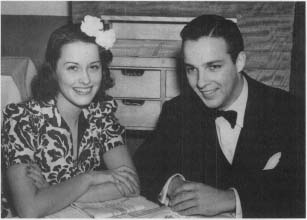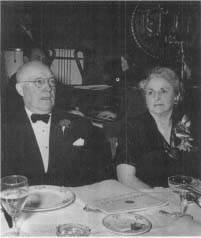Bing Crosby (93 page)
Authors: Gary Giddins

In the year dominated by
Gone With the Wind,
the ten highest-grossing movies of record were dramas, with the exception of two nostalgic Judy Garland pictures:
Babes in Arms,
which re-creates minstrelsy and glorifies middle America, and
The Wizard of Oz,
which tells how Dorothy regains her middle-American home after bringing order to a foreign land. This was the year of
The Hunchback of Notre Dame, Jesse James, Mr. Smith Goes to Washington, Stagecoach,
and
Drums Along the Mohawk.
Pundits who divined a trend toward sobriety, however, had but a year to find out how wrong they were:
Road to Singapore
and Preston Sturges’s films were just around the corner. Butler told a reporter in 1946 that
East Side of Heaven
earned between $3 million and $4 million and saved Universal from going under.
77
Had those numbers been accurate, his picture would surely have ranked in the top ten. On the other hand, everyone acknowledged
that it did bail out Universal.
In tracking the fortunes of far more conventional folks than the unholy Beebes,
East Side of Heaven
marked a moderating turn in the selling of Bing Crosby. Ahead of him lay his wackiest comedies, powerful dramatic roles,
and nostalgic detours, but Bing’s days as an acquiescent romantic lead, forever wooed, reluctantly wooing, were over.

Al Jolson was like Mr. Great Singer of all time. Maurice Chevalier was like Mr. Entertainer of all time. Frank Sinatra is
like Mr. Balladeer of all time. But Bing Crosby is like Mr. Everything of all time.
— José Ferrer (1974)
1
When Universal hired Cliff Work as its new production chief, it fired Charles R. Rogers, who then attempted to stay afloat
as an independent producer. One night at the Brown Derby, Rogers ran into the legendary vaudevillian and songwriter Gus Edwards,
who had recently announced his retirement and was rumored to be suffering from paresis. They spoke of the old days, and Rogers
told Gus that his life might make a good picture. After Edwards sent him an old autobiographical article he had written for
Collier’s,
Rogers made a preliminary production deal with United Artists. There was only one actor for the lead, and Rogers went to
Paramount to see whether he could borrow Bing. Paramount had no intention of loaning him and did not have to worry about Rogers’s
going to him directly, because
East Side of Heaven
fulfilled Bing’s outside option for the year. William LeBaron recognized a good idea, however, and invited Rogers to make
the picture for him.
It was, in fact, a brilliant idea — on paper. Bing had just scored a hit as a vicarious papa, waving good-bye at the close
of
East Side of
Heaven
with Baby Sandy in his arms. Playing Gus Edwards, he would be surrounded by dozens of vicarious kids. The more you thought
about the possibilities, the more compelling they became. Edwards was the king of kiddie acts back when Bing was first entering
elementary school. He initially made his mark in 1896 as a member of the Newsboy Quintet, an act that consisted of teenage
boys dressed in raggedy clothes, hawking papers and singing ballads. The German-born Edwards eventually proved a formidable
Tin Pan Alley composer and publisher, with songs like “In Zanzibar,” “In My Merry Oldsmobile,” “Sunbonnet Sue,” “By the Light
of the Silvery Moon,” and “Jimmy Valentine.” In 1907 he wrote his biggest hit, “School Days,” which sold 3 million records
(sung by Byron G. Harlan) and encouraged him to create a Broadway show in which forty young players strutted their stuff,
to the utter indifference of the Great White Way. Undaunted, Edwards distilled from the show a vaudeville act, “School Boys
and Girls,” that went on to enjoy phenomenal success for more than a quarter of a century. Imitators were legion.
By 1913
Variety
reported sixty-two
School Days
acts touring the country, all of them sure-fire and very inexpensive, for as show-business chroniclers Abel Green and Joe
Laurie Jr. observed, “The only props were a few desks and chairs [and] there were always stagestruck youngsters available
to sing and dance.”
2
In his many variations on the act (“Kid Kabaret,” “Band Box Revue,” “Blonde Typewriters”), Edwards introduced countless boys
and girls, many later prominent, among them Eddie Cantor, George Jessel, Groucho Marx, Walter Winchell, Elsie Janis, Sally
Rand, Eleanor Powell, Georgie Price, Lila Lee, Jack Pearl, Bert Wheeler, Mervyn LeRoy, Ina Ray Hutton, Ricardo Cortez, Charles
King, Ann Dvorak, and Ray Bolger. In 1939, a world remade by the Depression and an inevitable war, the country was once again
gripped by kiddiemania. Shirley Temple, pushing twelve, had only another year or two at the top, but the public responded
to children of all ages, from infancy (Baby Sandy) to teens (Deanna Durbin, Judy Garland). Had Humbert Humbert spent more
time at the movies, he might have been a happy, happy man.
One can imagine the humming of Paramount’s wheels: perfect vehicle for Bing, perfect vehicle for child performers, perfect
opportunity for shamelessly exploitative publicity (like importing sixteen orphans from as many orphanages for a press preview),
perfect opportunity
to discover and launch its very own Deanna Durbin. Her name was Linda Ware, a fourteen-year-old orphan from Detroit. The plenary
possibilities of Gus Edwards’s story and the wonderful talents he discovered were sacrificed to the studio’s vain hope that
her golden locks and faux-operatic voice would hit the kiddie jackpot. She was billed as “the new singing discovery of Charles
R. Rogers, Discoverer of Deanna Durbin.”
3
But Ware was no more a match for Durbin than Kitty Carlisle and Gladys Swarthout had been for Jeanette MacDonald.
Worse, the script somehow devolved from the story of Edwards to the story of Bing. By the time it was ready to shoot,
The Star Maker
so little resembled Edwards and his career that the name of the protagonist was changed to Larry Earl and history was mooted
with the attribution “suggested by the career of Gus Edwards.” That did not restrain Paramount from promoting “the heart-happy
story of America’s greatest showman, Gus Edwards.”
4
The fictional plot concerned a conflict involving a children’s welfare organization that bans the hero’s shows and forces
the hero to pioneer a newfangled invention. “It’s what they call radio or something,” one character remarks, allowing Bing/Larry/Gus
to predict: “In a few years — remember this now — that little gimmick will have every star in show business singing and acting
over it.” Every star but Gus Edwards, whose sole connection to radio was a local amateur talent program in Los Angeles for
a couple of seasons in the mid-thirties, shortly before his retirement.
That was not the only instance of Bing’s story subsuming Edwards’s. In the tradition of
Kraft Music Hall, The Star Maker
offered seventy-seven-year-old Walter Damrosch his cinema debut, playing himself, as well as accompanying and avowing the
greatness of Linda Ware. What Damrosch, who had convinced Andrew Carnegie to build a concert hall on New York’s Fifty-seventh
Street and Tchaikovsky to conduct its opening night, thought of her number — Tchaikovsky’s “Valse des Fleurs” with words by
Frank Loesser —is anyone’s guess, as no journalist is known to have asked him. Ware is less annoying as a trilling soprano
than as a barrelhouse interpreter of “The Darktown Strutters’ Ball,” to which she brings the very mannerisms Bing parodied
a few years later in
Going My Way.
The public did not encourage her career, but several reviewers kvelled:
“a brilliant coloratura, a winning personality and a pleasing countenance”
(Variety).
5
The drearily familiar Crosby character as personified by Larry Earl may be summed up by the titles of two of the songs he
sings: Edwards’s “If I Was a Millionaire” (1910) and Burke and Monaco’s “A Man and His Dream.” Once again, he is the stubborn
dreamer who cannot abide conventional jobs and seizes the day. What makes the picture different is that Earl acquires a wife.
The preeminent stars of the Hollywood musical, like those of horror films, were rarely depicted with spouses, except in biopics.
“Can you pay the grocer off with dreams?” asks Larry’s fiancée, Mary (a poorly written role played by a redheaded Mary Martin
lookalike, Louise Campbell). “Sure, if you’ll just say yes,” Larry tells her, and in contrast to all his previous movies and
most of those to follow, Bing marries.
The Star Maker
is, in fact, the only picture Bing ever made playing a happily married man. He was on the brink of divorce in Mack Sennett’s
One More Chance
and would marry and divorce in
Blue Skies.
He would be bitterly divorced in
Man on Fire,
philosophically divorced in
High Society,
widowed in
Just for You,
and in deep marital trouble in
The Country Girl.
He was on the prowl or celibate in everything else.
It is not far-fetched to surmise that, in part, Bing plays a composite of his younger self and his father: the irresponsible
husband who will not allow his wife to work yet cannot hold down respectable jobs that interfere with his joie de vivre. When
he proposes to Mary, Larry promises her furs, diamonds, servants; eighteen months later we see her ironing in a cold-water
flat as Larry spends their savings on a piano — not unlike Harry Crosby bringing home the phonograph and theater tickets while
Kate despaired of paying the grocery bill. Like Kate and Dixie, Mary takes steps to ensure Larry’s success, sneaking into
the car of impresario F. F. Proctor and charming him into seeing her tactless husband. Proctor installs Larry on the bottom
of a bill that lists several of Bing’s favorite vaudeville artists, notably Eddie Leonard, Julian Eltinge, Van and Schenck,
and Blanche Ring, most of whom he and David Butler would soon contrive to present in
If I Had My Way.
The first half of
The Star Maker
has many pleasantries, not least a re-creation of the Newsboys (Larry is too old to be in the act, so the picture has him
discovering them on a street corner, dancing to a hurdy-gurdy). Bing enjoyed the seven newsboys, among them Darryl Hickman,
whom the Crosby talent agency signed and placed in
The Grapes of Wrath,
a prelude to his dozens of film roles in the forties and fifties; Danny Daniels, who did much of the solo tap dancing in
the picture and went on to a long career as a choreographer on stage and screen; and Dante DiPaolo, who was a specialty dancer
in movies, a dance director in Las Vegas, and an actor in Italian epics and
giallos.
“I auditioned five times,” DiPaolo remembered. “Bing was only at the final audition. That’s when Le Roy Prinz, our dance
director, told me not to change a thing, because I was singing ‘Star Dust,’ and he told me, Do it exactly that way because
Bing really likes ‘Star Dust.’There must have been six, seven hundred kids from Hollywood auditioning, not just for the seven
newsboys, but all the kids in ‘School Days,’ tons of auditions.”
6

June Kuhn was a Sarah Lawrence student when she met Bob Crosby on her Easter break. Their marriage got off to a rocky start
but lasted fifty-four years. This picture was taken in October 1938, about the time of the “You Must Have Been a Beautiful
Baby” session.
Rory Burke Collection

